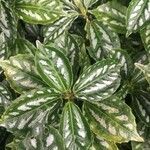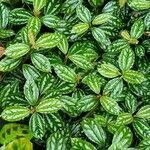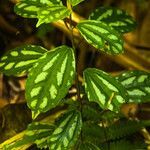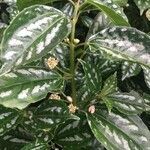Herbs perennial or subshrubs, rhizomatous, glabrous, dioecious. Stems erect, 15-40 cm tall, somewhat succulent, woody at base; stems, stipules, petioles, and leaves densely covered with cystoliths. Stipules caducous, green, brownish when dry, oblong, 10-13 mm, papery, longitudinally 2-ribbed; petiole subequal in length, 0.7-1.5 cm; leaf blade obovate, subequal in size, 2.5-6 × 1.5-3 cm, papery, 3-veined, lateral veins 3 each side, external secondary veins anastomosing by margin, adaxial surface with 2 interrupted white grooves, base broadly cuneate or subrounded, margin obscurely dentate or erose, apex mucronate. Inflorescences in pairs; male inflorescence a capitulum, peduncle 1.5-4 cm; glomerules 6-10 mm in diam.; bracts broadly ovate, ca. 3 mm. Male flowers: pedicel 2-3 mm, in bud pear-shaped, ca. 2.5 mm; perianth lobes 4, cymbiform, connate 1/2 of length, subapically corniculate; stamens 4; rudimentary ovary conic. Female flowers subsessile; persistent perianth lobes 0.5-0.7 mm, 1/2 as long as achene; staminodes oblong. Achene ovoid, ca. 1.5 mm, compressed. Fl. Sep-Nov, fr. Nov-Dec.
More
A herb. It is succulent when young. It grows 40 cm tall. It keeps growing from year to year. The stems are 4 angled and swollen at the nodes. The leaves are 9 cm long by 5 cm wide. They are in pairs and oval. There are teeth near the tip. The flowers are in the axils of the leaves. They are in round clusters.




